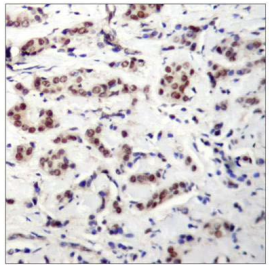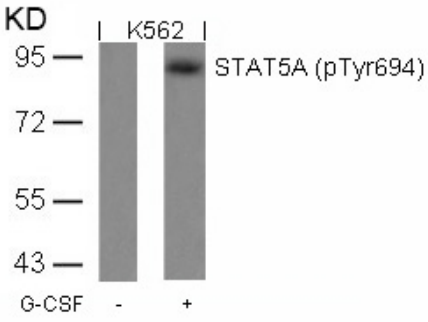Anti-STAT5A (phospho-Tyr694) Antibody (43048)
Data
- -
- -
Antibody DetailsProduct DetailsReactivity Species Human ⋅ Mouse ⋅ Rat Host Species Rabbit Immunogen Peptide sequence that includes phosphorylation site of tyrosine 694 (D-G-Y(p)-V-K) derived from human STAT5A and conjugated to KLH. Product Concentration 1.0 mg/ml Formulation PBS (without Mg2 and Ca2 ), pH 7.4, 150mM NaCl, 0.02% sodium azide and 50% glycerol. State of Matter Liquid Product Preparation Affinity-purified on phosphopeptide; non-phosphopeptidereactive antibodies were removed by chromatography on non-phosphorylated peptide Storage and Handling This antibody is stable for at least one (1) year at -20°C. Country of Origin USA Shipping Next Day 2-8°C Applications and Recommended Usage? Quality Tested by Leinco Immunoblotting: use at dilution of 1:500-1:1,000. A band of~90kDa is detected.
Immunohistochemistry: use at dilution of 1:50- 1:100. These are recommended working dilutions. End user should determine optimal dilutions for their applications. Each investigator should determine their own optimal working dilution for specific applications. See directions on lot specific datasheets, as information may periodically change. DescriptionSpecificity Rabbit Polyclonal Antibody specific to STAT5A (phospho-Tyr694) Background Signal transducers and activators of transcription (STATs) are transcription factors that play important roles in signaling pathways induced by many different cytokines and growth factors that regulate cell growth and differentiation, the immune response, antiviral activity, and homeostasis. Their activation and mechanisms of action are examples of direct signaling to the nucleus by extracellular polypeptide ligands without the involvement of second messengers, tyrosine phosphorylation of transcription factors, or transcription factors that make direct contact with membrane-bound receptors and DNA. Since the discovery of STAT 1 and 2, the family has been expanded to seven members. Antigen DetailsFunction Carries out a dual signal transduction and activation of transcription. Mediates cellular responses to the cytokine KITLG/SCF and other growth factors. Mediates cellular responses to ERBB4. May mediate cellular responses to activated FGFR1, FGFR2, FGFR3 and FGFR4. Binds to the GAS element and activates PRL-induced transcription. Regulates the expression of milk proteins during lactation. {PubMed:15534001}. NCBI Gene Bank ID UniProt.org Research Area Phosphospecific Antibodies References & CitationsTechnical Protocols |




